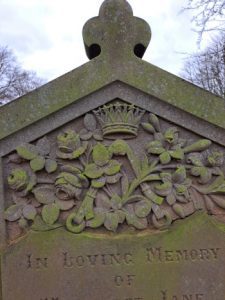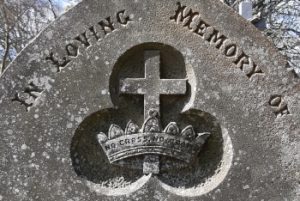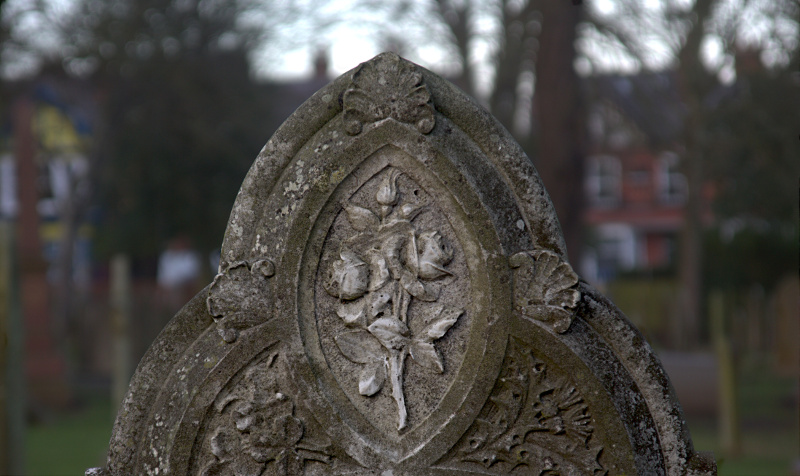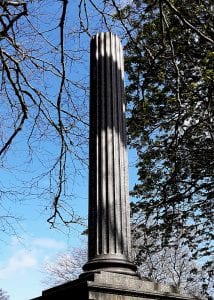Symbolic art on gravestones
Gravestones are more than a way to memorialise loved ones. They can often be works of art and have symbols with special meanings to those left behind. Symbolism has been a part of cemeteries for centuries, although the images have changed over time. Headstone symbols commonly found churchyards and cemeteries in the UK includes Anchors, Angels, Broken Columns, Celtic Cross, Crowns, Doves and many more. A brief interpretation of a few can be found below. Although this is not an extensive list, it is a work in progress.
IHS Headstone Symbol
The IHS headstone symbol represents Iesus Hominem Salvator (Jesus Saviour of Mankind). The letters are know as a christogram, a combination of letters that form an abbreviation for the name of Jesus Christ. The first three letters of Jesus in Greek.
This is the Christian symbol that can appear in two forms, as the letters IHS or as a monogram. Both forms only differ in presentation. The meaning does not change as letters or a monogram. It can be alternatively be spelled IC, XC, or XPS.
There are many different interpretations of the meaning, however all agree it essentially stands for the name of Jesus Christ. The symbol was used frequently by the French St Bernard in the 12th Century as he urged his followers to give devotion to the name Jesus.
Here are a few facts about the symbol IHS:
- The most common translation is that it stands for the first three letters of Jesus Christ’s name in Greek, iota eta sigma. When capitalised, the word eta appears as ‘H’
- IHS can stand for for the Latin phrase Iesus Hominum Salvator, or Jesus Saviour of Mankind.
- It can also be traced back to an 8th century Latin phrase “dn ihs chs rex regnantium” which translates to “Jesus Christ is King of Kings”. In this instance, IHS simply stands for Jesus, spelt in the Latin as Ihesus.
- As “In Hoc Signo” which translates to “In This Sign”, it is often used as a reference to the crucifixtion and the Christian faith.
- As IHSV it stands for “In Hoc Signo Vinces” or “In this sign you shall Conquer” which is in refernce to the battle of Constantine over Maxentius in which the Emperor was believed to have seen the sign of Jesus Christ in the sky and heard the phrase repeated to him.
- In her research Liz Blades, has been told that it stood for In his Service or In his Steps.
Examples from our cemetery



Angel Headstone Symbol
Angels found in the cemetery are a symbol of spirituality. They guard the grave and are thought to be messengers between God and man. They are a comforting addition to the remembrance for the relatives of the deceased when included in a memorial or headstone. Angels are seen as more than simply messengers between God and humankind. Angels are also seen as guiding and protective spirits who watch over us in day-to-day life and death. They also bring an air of peace, beauty and strength to memorial.
The idea of angels having wings dates back to the Byzantine art of the 4th century. As Christianity evolved following this period the idea and appearance of angels changed from being cherubic or cupid like to being a more human image.
You will find graves and memorials with many different designs and representations for angels which can have different meanings. A popular design over the years has been the weeping angel, also known as the angel of grief. This image of an angel could have outspread wings, kneeling or slumped in grief over the headstone, or a combination of these.
Here are a few facts about the symbol Angel:
- An Angel praying in a cemetery often indicates religious devotion.
- An Angel pointing upwards towards heaven with outstretched wings usually represents a soul being escorted to heaven
- An Angel looking downwards and bowing often represents sorrow or mourn of a sudden or untimely death.
- An Angel weeping usually signifies grief over an untimely death.
- An Angel blowing a trumpet on a headstone signifies the Day of Judgement and a Call to Resurrection.
- Sleeping angels can be seen as guardians of our deceased loved ones. Sleep is the link between life and death quite often.
- Many Angels gathered together in the clouds- represents Heaven.
Examples from our cemetery


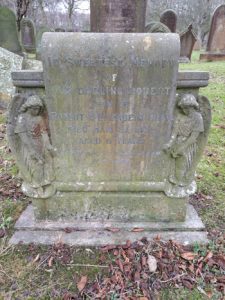
Celtic Cross Headstone Symbol
Celtic headstone history is steeped in symbolism dating back many centuries. As a symbol of Christianity, the Celtic cross first appeared in the 8th Century and was reputedly introduced to Ireland and Britain by St Patrick and the early Christian missionaries. Some believe origins of the ring on the cross represent the Roman sun-deity Invictus. It is believed that the early Irish monks borrowed this idea of the sun god to explain Christ’s halo, to help explain the concept of Christianity to Celtic pagans.
As pointed out above, the Celtic Cross has its origins in pagan culture, as much of Christian symbols and celebrations do. By copying pagan rituals that were well known to the local people, it was easier to convert the ‘barbarians’ to Christianity. Another view is that the Celtic Sun is represented by the circle through the cross.
Celtic headstones are a traditional form of memorial that stands out from all other types of headstone. They represent the religious beliefs of the recently departed family member and publicly display their hope for the future with their impressive and dignified appearance. Because of the distinctive shape the Celtic Cross headstone will not be missed and can seen from quite far off in a cemetery. Providing a real focal point for the mourning family members.
It is generally accepted that the circle around the crosspiece symbolizes eternity. It can also serve as a double symbol of eternity and unity, both that of the Son with the Father and the Holy Spirit and that of the believer with the Trinity.
Here are a few facts about the Celtic Cross Symbol
- The Celtic cross is commonly associated with Christianity, but its origins can be traced back to pre-Christian times.
- While its origins are disputed, it remains a symbol of Christianity, with pagan associations.
- The symbol was linked to pagan beliefs and practices. For instance the arms of the cross are thought to represent the four elements (air, water, fire, earth) and/or the four directions (north, south, east, west).
- The cross represents Christianity while the circle represents the sun and Celtic view of eternity, with no beginning and no end.
- It is thought that St Patrick introduced the Celtic Cross to Ireland to help introduce Christianity to the pagan populous.
- It is generally accepted that the circle around the crosspiece symbolizes eternity.
- Celtic headstones are used to represent the religious beliefs of the recently departed family member and publicly display their hope for the future.
Examples from our cemetery
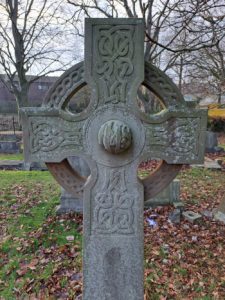



Crown Symbol Headstone Symbol
A crown on a headstone typically represents the Crown of Life or symbolizes Christ, also known as the king of kings.
It represents the glory of life after death and the victory and triumph over death, or that earthly life includes suffering, and the afterlife, victory. As men fashioned crowns out of more enduring substances like gold, they added little spikes to call to mind power and authority.
A crown is often combined with other icons. A finger pointing up through a crown for instance indicates the deceased has gone to heaven through the power of Christ’s resurrection.
A crown with a cross in the centre on the other hand is symbolic of the reward in heaven (the crown) coming after the trials in this life. The departed soul gaining victory over death through Christ the King.
It is a Christian symbol of course but is also associated with Freemasonry and The Knights Templar. But in general it is associated with Christianity.
Here are a few facts about the Crown symbol
- Crown on a headstone represents the Crown of Life
- Mounted with a cross indicates that earthly life includes suffering, and the afterlife, victory.
- The crown typically symbolizes Christ.
- A finger pointing up through a crown indicates the deceased has gone to heaven through the power of Christ’s resurrection.
- A crown with a cross in the centre is symbolic of the departed soul gaining victory over death through Christ.
- A Crown is a symbol of triumph over death.
- It can also represent the belief that the deceased is now in the presence of God.
- Also an emblem used with the Christian Scientist religion, and is a symbol of the Knights Templar.
Examples from our cemetery

